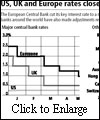The rebound in global equity markets is not entirely unfounded. The recent severe decline in economic activity, trade, consumer confidence and equity prices, suggested the worse was either behind us, ?in the price? or both. As a result of massive government support and effective ownership of large swathes of the banking system in the US and Europe, stability has returned to the banking system. And recessions can be severe or long, but they are seldom both and they always end. Nevertheless, this is not the beginning of the end of recession. This is something more subtle than that.
I suspect we are entering a new phase of the economic and market cycles where we will see?at long last?a greater differentiation of economies, markets and sectors. Deleveraging has gripped financial markets for the past 20 months. In a deleveraging environment, there is little differentiation of assets?good and bad have to be sold for liquidity. Indeed, the ?good? appear to fall the most in price as they are the ones that can be sold. This is not an environment that favours value investing. But if there is anything good about de-leveraging, it is that it is often quickly over. The dramatic de-leveraging that overwhelmed LTCM, the hedge fund, in October 1998, probably began on August 17 of that year with the Russian default, and ended soon after the January 19 devaluation of the Brazilian real, lasted just five months. Time, government ownership of banks and a sense that the US Federal Reserve?s stress tests indicate that the banking system is not far from being well-capitalised will, in my judgment, lead to an end of deleveraging. Good news for value investors.
 Where is there value today? Let me focus internationally in this column. Juxtaposed with economic gloom and policy wretchedness are tentative signs of economy recovery in Europe. The stylised story is that firms cut back sharply on their inventory in the face of falling demand?European GDP contracted as fast as in the US?and there are signs that there is now little room for production to fall further without failing to satisfy current, diminished levels of consumption.
Where is there value today? Let me focus internationally in this column. Juxtaposed with economic gloom and policy wretchedness are tentative signs of economy recovery in Europe. The stylised story is that firms cut back sharply on their inventory in the face of falling demand?European GDP contracted as fast as in the US?and there are signs that there is now little room for production to fall further without failing to satisfy current, diminished levels of consumption.




Moreover, despite the appearance of extreme reluctance amongst European politicians and central bankers to follow US demands for policy stimulus, the scale of fiscal and monetary stimulus in Europe is in fact on par with that in the US?perhaps as a result of more extensive ?automatic stabilisers? in the form of unemployment and other transfer payments. Arguably, the stimulus in Europe is better targeted. Precious little resources are being wasted on a politically pleasing tax cut. While the perception is that Europe is a policy laggard, on the ground we will see signs that European companies are pulling out of the recovery as quickly as anyone else, if not more so.
China is a surprisingly similar story. It will not be easy or quick to reorient the Chinese economy away from exports to the US. However, there has been a substantial inventory correction, a substantial fiscal stimulus and now signs of some stabilisation. Reality is no worse and perhaps slightly better than perception.
The opposite may be the case in North America. The market?s perception is of extreme policy activism in the US and some insulation from the worse effects of the crisis as a result of an earlier regulatory conservatism in Canada. However, in months to come, we are likely to see continued economic weakness as savings rates in North America return to more normal levels. A normalisation of savings rates around the world will leave the Anglo-Saxon countries facing a far greater retrenchment in consumption than European countries. This economic reality is not yet priced-in to markets. The plus for Canada is that its currency is still cheap while energy prices have rebounded. There is room for the currency, at least, to play some catch up.
A retrenchment in consumption by Anglo-Saxon countries will lead to falling export demand in China, Japan, Russia and Brazil. While the focus has been on China, Japan and Brazil are turning out to be as poorly positioned. Exports have collapsed. The yen and real are overvalued and have a long way to fall before currency weakness helps to stabilise exports. Holding the yen up so far has been a repatriation of Japanese funds held abroad. Once the global economy stabilises and markets impart greater differentiation, these funds may well flow out again, triggering yen weakness. In the meantime, the fall-off of export demand in Japan, combined with a strengthening currency, will weigh particularly heavily on the Japanese equity markets. In short, differentiation will soon be back. In anticipation of that, I would position to be exposed to the equity markets and currencies of the UK, Canada and the euro area?in that order?and reduce exposure or be underweight Japan, Russia, Brazil and the US.
The author is chairman of Intelligence Capital Ltd, emeritus professor of Gresham College and member of the UN Commission of Experts on International Financial Reform




















